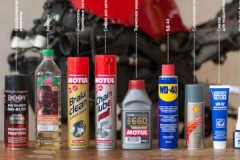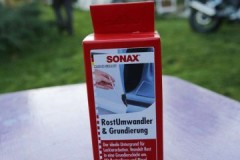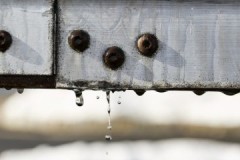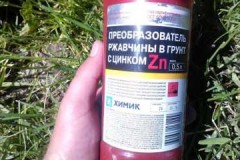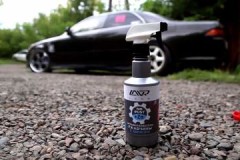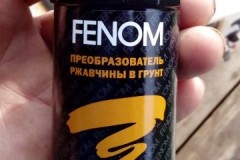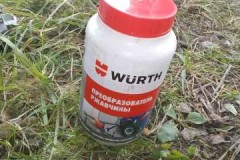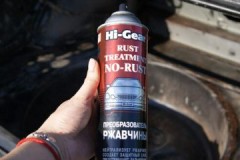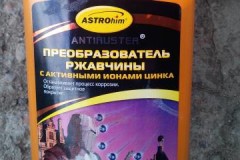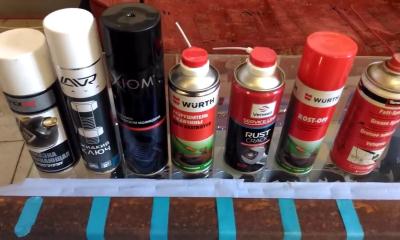 Metal has a number of advantages, which is why it is so popular in various fields. However, one of the negative qualities is the susceptibility to corrosion.
Metal has a number of advantages, which is why it is so popular in various fields. However, one of the negative qualities is the susceptibility to corrosion.
To combat this disadvantage, a rust converter (modifier) was created. When using it strictly according to the instructions, the removal of corrosion products and the prevention of its occurrence in the future is guaranteed.
Content
What is it, what is it for, how does it work?
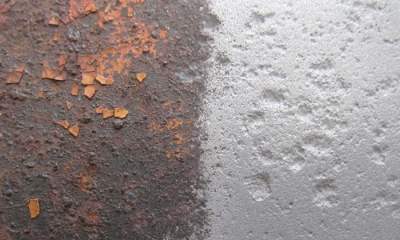 Rust converter is a chemical compound.
Rust converter is a chemical compound.
How does it work? After application to the damaged area included in most modifiers orthophosphoric acid affects iron oxides, especially iron oxide (III).
As a result of a chemical reaction, a protective barrier is created through the transformation of corrosion products.
If the converter contains zinc compounds, then the principle of operation looks different. Zinc atoms combine with oxygen, thereby forming a film... It provides protection and prevents further rust formation.
Additional components also take part in a chemical reaction, responsible for ensuring the inactive state of the protective layer formed on the surface.
You can learn about what a zinc rust converter is and how it works. here.
Varieties
There are many options for rust converters. Each of them differs in composition and principle of interaction with corrosion products.
The main types are:
- Plain. It is based on one active ingredient - phosphoric acid. Blocking of the oxidation process is achieved through a chemical reaction with elements of corrosion. Stable inactive compounds are formed. The disadvantage is the need to remove unreacted acid residues after using the converter. Otherwise, they will provoke the appearance of rust.
- Complicated. The composition includes several active ingredients: phosphoric acid, zinc salts, manganese. As a result of the decomposition of iron oxides under the influence of phosphoric acid, phosphates are formed. In parallel to this process, salts enter into a reaction, a protective barrier is created, and acid residues are neutralized.
-
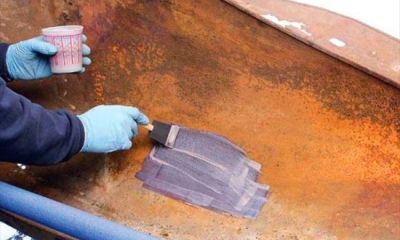 Priming. A distinctive characteristic is the creation of a primer layer on the surface. Especially relevant before applying paint and varnish coatings.
Priming. A distinctive characteristic is the creation of a primer layer on the surface. Especially relevant before applying paint and varnish coatings.Release form - two solutions. One contains phosphoric acid, the other contains salts. The solutions are mixed before use. The shelf life of the resulting mixture is limited to 5 days.
- Neutralizing. It is an impregnation consisting of a paint and varnish base and substances (inhibitors) that suppress or retard the development of the corrosion process. When applied to the surface of the converter, the inhibitors form a protective film.
- Filming from petroleum formulations... There are two generations: I and II. First generation formulations include petroleum resins, solvents, additives and a variety of inhibitors. After surface treatment, a soft protective film is formed, which does not have high strength. Consequently, the coating needs regular renewal of the protective layer.
Second generation formulations are distinguished by the presence of a water-based solvent. They form a stable layer that guarantees protection not only against rust, but also against mechanical damage.
Recommendations for use
To improve the efficiency of the rust converter, it is necessary to apply it correctly... A specific sequence of operations is recommended.
There are three main stages:
 Preparatory. Before applying the converter, the surface needs to be cleaned of dust and dirt. Then the damaged area should be degreased with a solvent.
Preparatory. Before applying the converter, the surface needs to be cleaned of dust and dirt. Then the damaged area should be degreased with a solvent.- Main. Implies directly treating the surface with a rust converter.
To do this, it is necessary to use the most suitable remedy based on the consistency and composition of the preparation in order to ensure maximum coverage of the damaged area.
- Final. It involves the removal of the remnants of the converter after a chemical reaction, if required by the instructions for use of this drug. Some products do not need to be rinsed off.
A prerequisite is also the measurement of the thickness of the rust layer. The allowed parameter is 0.1 mm.
How to wash off?
Some rust converters do not need to be rinsed off after application. However, most formulations require the removal of residues from the treated surface. Otherwise, the opposite effect will occur - rust will appear.
There are some useful tips on how and with what to wash off the modifier. rust:
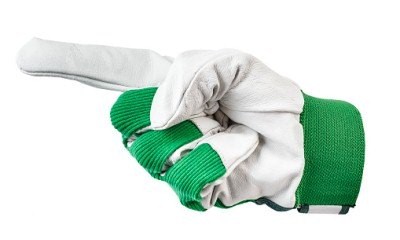 the converter should be washed off after the treated surface has dried;
the converter should be washed off after the treated surface has dried;- it is recommended to use special means - silicone remover or white spirit;
- in the absence of a special tool, you can use laundry soap, which neutralizes the unreacted acid;
- after removing the remains of the converter, rinse the surface thoroughly with water;
- moisture must be removed with a dry cloth.
It is recommended to prepare in advance everything you need to wash off the modifier in a timely manner. This ensures not only the elimination of rust, but also the absence of drips in the converter. How to wash off the rust converter will tell this article.
Selection rules
Before purchasing a rust modifier, it is recommended to analyze the purpose of its further use, since each drug interacts with metal in a different way.
To restore the damaged surface of the body, it is recommended to opt for a primer... If it is necessary to treat areas that are not subject to further staining, then the best option is products with the addition of special stabilizers.
The cost, as a rule, is slightly higher, however, the result is also an order of magnitude higher than little-known companies. This is explained by constant testing of products, control of all stages of creating a product by well-known manufacturers.
The form of release should also be taken into account.... It is advisable to use a concentrated composition before painting. If the area to be treated has a large area, then it is advisable to opt for an aerosol. This will greatly simplify the application process.
Price and where to buy?
 There is a wide selection of rust converters on the market.
There is a wide selection of rust converters on the market.
The most budgetary option costs about 100 rubles... The price of expensive modifiers ranges from 4000 to 4500 rubles. Such a significant difference is explained by the manufacturer, composition and volume.
Having chosen the appropriate option, you can order it online or purchase it in a specialized store. In this case, preference should be given to sellers with a good reputation. This acts as a kind of guarantee for the purchase of a quality product.
Top 5 best
When choosing a rust converter, one should also take into account their demand in the market. As a rule, the more popular the remedy, the more effective it is..
The top 5 best modifiers are as follows:
| Name | pros | Minuses | Price |
| Tsinkar | eliminates corrosion products, forms a protective film | highly toxic | 500 ml ≈ 180 rubles |
| Sonax | converts rust into a stable undercoat | must be applied in two layers | 125 ml ≈ 675 rubles |
| Hi-Gear | ease of use, the ability to handle hard-to-reach places | high acid content, the composition can corrode the paintwork | 255 g ≈ 700 rubles |
| Wurth | environmentally friendly, reliably prevents corrosion | inadmissible contact with the painted surface | 1 liter ≈ 3510 rubles |
| Laurel | lack of aggressive acids in the composition, removes rust on large areas | requires reapplication to increase efficiency | 480 ml ≈ 225 rubles |
The above modifiers have proven to be the best. According to reviews, they effectively eliminate corrosion products. Moreover, the cost is quite adequate. The rating of the best rust converters is presented in this publications.
Can I make a rust modifier myself?
If it is impossible to purchase a modifier, you can make it yourself. The easiest way is to mix phosphoric acid with water in a 6: 4 ratio. However, finding acid is sometimes difficult.
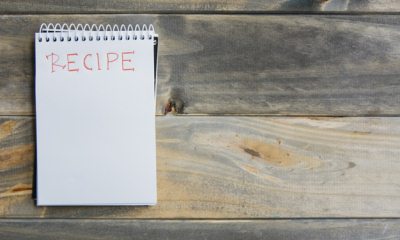 In this case, you can use the following recipe:
In this case, you can use the following recipe:
- 1.5-2 liters of boiled water;
- 1.5-2 liters of citric or oxalic acid;
- 15 grams of baking soda.
First you need to mix the first two ingredients. After that, add soda. The reaction takes about 35 minutes. The converter is ready to use.
The resulting solution is recommended to be applied to the damaged area with a cloth made of natural materials.... In the process, it is necessary to ensure that the surface remains wet for at least 15-20 minutes.
You can find out how to make a rust converter yourself here.
Safety engineering
When using rust converters, regardless of the composition and manufacturer, safety precautions must be observed.
Main activities:
- It is recommended to test the product on unnecessary parts before use in order to prevent unwanted effects.
- All work should be carried out in a well-ventilated area or outdoors. This will reduce the impact of toxic substances on the human body.
- When treating the surface with a rust modifier, wear rubber gloves, goggles and a mask or respirator. The exposed areas of the body should be kept to a minimum. Since contact with the skin can provoke burns.
You can find out how to use the rust converter correctly here.
Conclusion
The rust converter is a fairly effective means of combating corrosion. Consequently, the composition assumes the presence of toxic and aggressive components to one degree or another.
In order not to harm your own health, it is recommended to choose proven modifiers, observe safety precautions during use.
